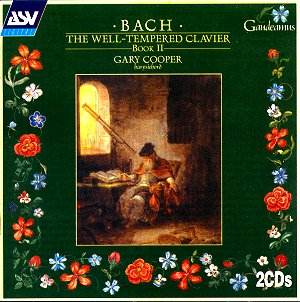Gary Cooper is a young British harpsichordist who has performed extensively
in baroque ensembles; he also directs the New Chamber Opera, where he
performs music from Mozart to Britten. This can seem a bit surprising,
since harpsichordists who record music such as this generally do not stray
much from the baroque idiom.
From the very first notes of the first prelude, it
is clear that Cooper is taking a unique approach to the Well-Tempered
Clavier. First, his instrument, a copy of a harpsichord by Christian
Zell, has a dark, rich sound, which contrasts agreeably with the often
harsh-sounding harpsichords heard on recordings. But this does not surprise
as much as his tempo for the first prelude - far slower than most performances,
Cooper seems to lose the thread of the piece as he searches for the
right rhythm.
Not all his tempi are slow, but the total timing for
the two CDs is much longer than other harpsichord recordings: Blandine
Verlet plays book II in 125 minutes; Gustav Leonhardt in 136; only Davitt
Moroney comes close, at just over 150 minutes. This slower tempo is
often heard in the preludes, such as the C sharp prelude, which, at
2.34, is quite long. Are these tempi problematic? Cooper sometimes has
a better relationship between his preludes and fugues, because of the
slower preludes, than many performers.
Yet this is still shocking. The prelude IX in E is
over 6 minutes long, and is a totally different piece than what most
performers play; the tempo is so slow that it is hard to recognize.
Its companion fugue is also very slow, sounding more like an organ chorale
played on the harpsichord than a fugue written for this instrument.
The 3 part fugue XIV in F sharp minor is another example of a fugue
that is much slower than usually heard, giving it a sound that is hard
to reconcile. And the G minor fugue, a brilliant example of foot-tapping
rhythm, at the usual tempo, here sounds drab and lifeless.
The question of tempo is one area where performers
are relatively unlimited. Bach only left tempo notations in a few pieces,
and performers are free to play as they wish. While there is a "tradition"
of Bach tempi for such works, there is no reason not to play them differently.
Listening to this recording, one can notice many nuances, especially
in the fugues, that are less apparent in other performances. However,
when Cooper plays rapidly, such is in the prelude XV in G, it comes
as a surprise; after becoming used to his slower tempi, a "normal" tempo
sounds almost like the Flight of the Bumblebee.
It is hard for me to decide what sort of recommendation
to give to this recording. It is quite disconcerting, yet there are
some elements of the pieces that are heard in a new light. In the end,
this is probably a disc for those quite familiar with the Well-Tempered
Clavier who are interested hearing it performed in a radically different
manner. Neither exceptionally good nor poor, this is a unique performance.
Kirk McElhearn

